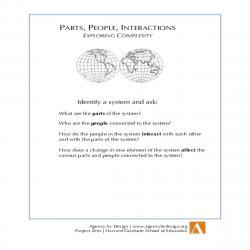Amanda Riske's collections
Visual Data and Contexts: Camilo José Vergara
<p>A collection of Camilo José Vergara's work 65 East 125th Street, Harlem.</p>
 Amanda Riske
Amanda Riske
18
Geometry Sort
<p>This is a card sort created for the MTE 311 geometry section of the course. Students will make 4-5 categories using geometric properties and sort the artworks into those categories. </p>
 Amanda Riske
Amanda Riske
1
HW Caught in the Folds MTE281
<p>Students will look at geometry in origami as an inspiration to art, design, and innovations in science.<br></p>
<p>This is a follow-up take-home assignment from using selected Issey Miyake’s fashion designs and connections to origami this Learning Lab Collection will highlight artworks that are designed in two-dimensional (2D) and three-dimensional (3D) forms, how to plan/engineer for complexity, and how combinations make a difference in the end product.</p>
<p></p>
<table><tr><td><p>Description </p></td><td><p>Student Instructions </p></td><td><p>Teacher Notes</p></td></tr><tr><td><p>Slide 1: Collections in Motion: Folding Miyake Tank </p></td><td><p>Watch the video, then answer the questions in the quiz</p></td><td spellcheck="false"><p>Encourage students to watch the video more than once. </p></td></tr><tr><td><p>Slide 2: 2D paper crane</p></td><td><p>Read about history of the paper crane and cultural significance.</p></td><td><p>These two slides are visualizations that can help students make connections between origami and Miyake’s work. </p></td></tr><tr><td><p>Slide 3: 3D paper crane</p></td><td>
</td><td>
</td></tr><tr><td><p>Slide 4: Origami instructions for paper crane. </p></td><td><p>Make the crane twice.</p><p>One version keep in the 3D form</p><p>Second version: Unfold and analyze the line features. If you need to you can use a ruler to accent the lines. </p><p>Identify the parallel line properties, types of angles, and any special features of the folds. </p><p>Extensions: Make connections between the folds and the aspects of the crane. </p></td><td>
</td></tr><tr><td><p>Slide 5: Collections in Motion: Folding Miyake Long Skirt</p></td><td><p>Watch the video, then answer the questions in the quiz, and sketch a rough draft of the 2D plan for the skirt. </p></td><td><p>Students can watch the video of the skirt a couple of times, answer the questions in the quiz and sketch the skirt. Remind the students that it does not have to be perfect. The goal is to identify the shapes used. </p></td></tr><tr><td><p>Slide 6: In-Ei Mendori</p></td><td><p>Students will interview each other and make predictions of what the 2D version of the sculpture will look like. </p></td><td><p>It is important that they complete the quiz before advancing to the next slide. </p></td></tr><tr><td><p>Slide 7: In-Ei Mendori</p></td><td><p>Students will evaluate their prediction of the sculpture. </p></td><td><p>Possible point for class discussion. </p></td></tr><tr><td><p>Slide 8: Thinking routine</p></td><td><p>With your group members answer the questions for one of the Miyake designs. </p></td><td>
</td></tr><tr><td><p>Slide 9: 40 under 40: Erik Demaine</p></td><td><p>Watch the video of folding.</p><p>Read Erik Dermaine’s short biography and research interests</p></td><td><p>Students will read about Dermaine’s interests and do some research on the applications of geometry. </p></td></tr><tr><td><p>Slide 10: Science Innovations</p></td><td><p> Watch the video on science innovations. </p></td><td><p>Lead a discussion on the aspects of origami and the importance in problem solving in science. </p></td></tr><tr><td><p>EXTENSIONS</p><p>Slide 11: Fold it website</p></td><td><p>Connections between biology and origami. </p><p>Read through the website and use the folding tool. </p></td><td><p>Students could make proteins with origami paper and analyse the different line properties and relationships that are on the paper after unfolded. </p></td></tr><tr><td><p>Additional resources</p></td><td>
</td><td><p>Documentary on origami- teachers can watch for more background information or use clips during the lesson. </p><p>Article: <a href="http://www.opb.org/artsandlife/article/folding-paper-explores-art-history-and-application-of-origami/">http://www.opb.org/artsandlife...</a></p></td></tr></table>
<p><em>#visiblethinking</em></p>
 Amanda Riske
Amanda Riske
7
Short Hip Hop History
<p>Looking at three videos that speak about the influences of Hip-Hop artists and how hip-hop is used for activism.</p><p>#SmithsonianMusic<br /></p>
 Amanda Riske
Amanda Riske
5
Changes in Education and Using Resources available
<p>This collection is used during a course on project based learning and place based learning. Teachers used this as an entry activity to looking at exploratory education as well as how to navigate the learning lab. </p>
 Amanda Riske
Amanda Riske
32
Calculated Change
<p>Through this collection students will learn about how people exposed systemic societal issues to advocate for change in policy and change in thought. The thread that brings these practitioners together is that they slowly looked at the issues, exposed the truth, and did not only rely on data but a combination of people, stories, to back up their claims and advocate for change and education. </p>
 Amanda Riske
Amanda Riske
23








